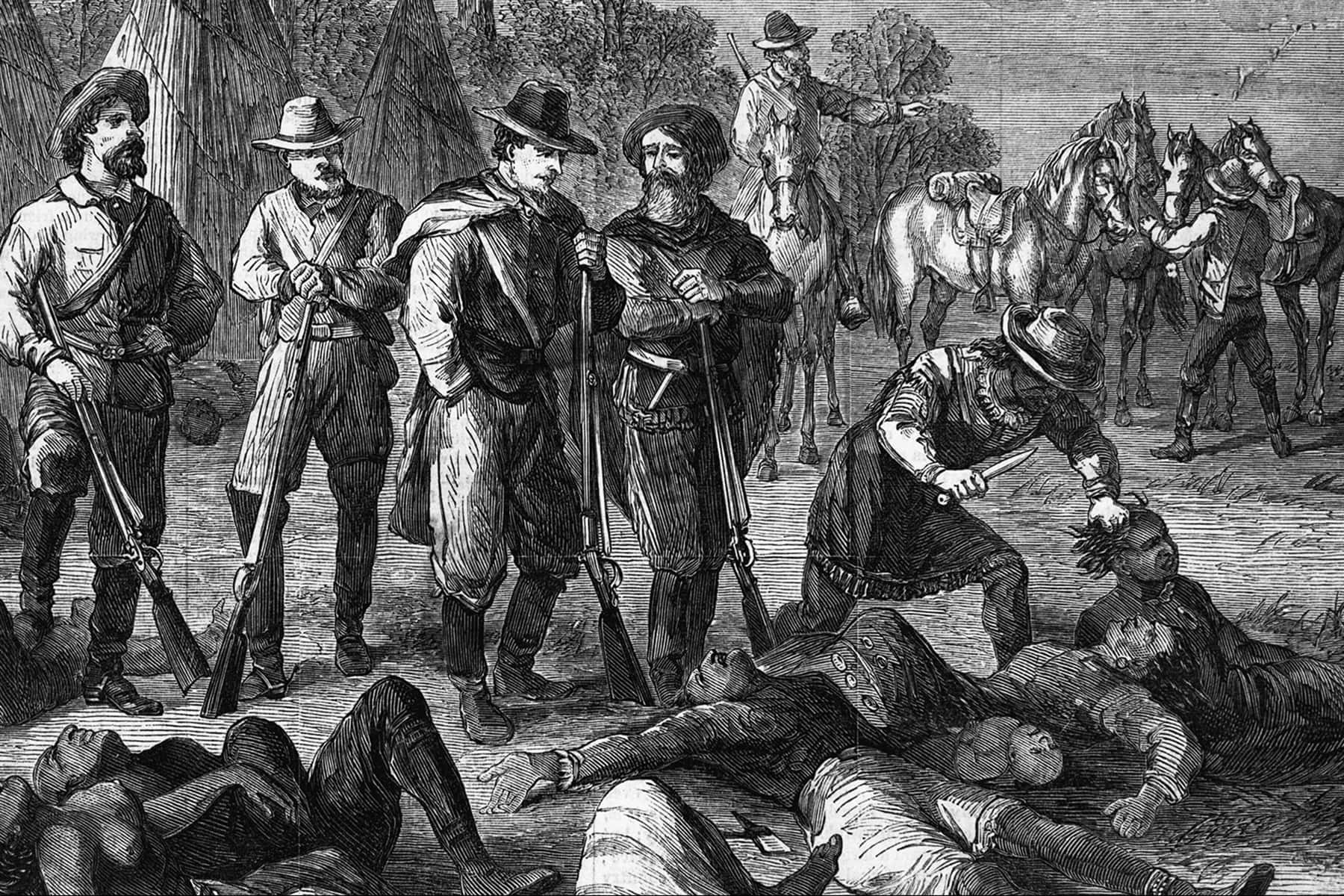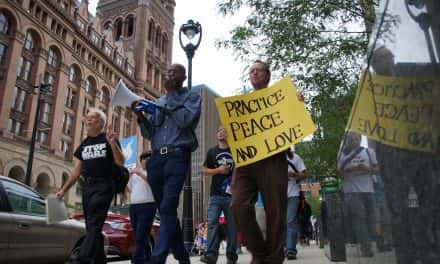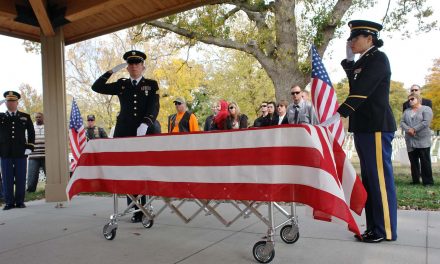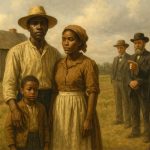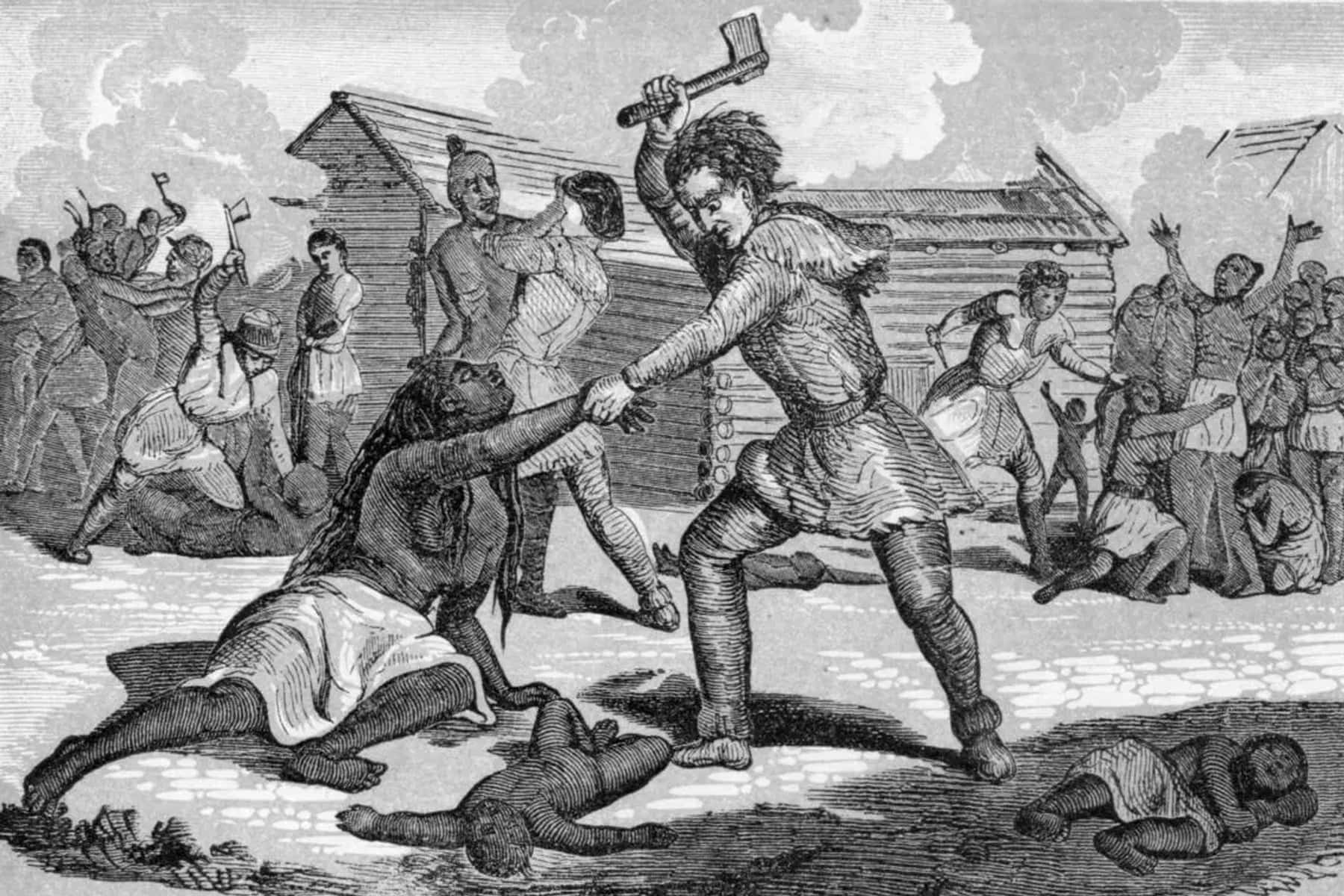
“Eight negroes lynched since last issue of the Free Speech one at Little Rock, Arkansas, last Saturday morning where the citizens broke into the penitentiary and got their man; three near Anniston, Ala., one near New Orleans; and three at Clarksville, Ga., the last three for killing a white man, and five on the same old racket – the new alarm about raping white women. The same programme of hanging, then shooting bullets into the lifeless bodies was carried out to the letter.” – Memphis Free Speech May 21, 1892
None of us who were around will forget the bombing of the Alfred P. Murrah Federal Building in Oklahoma City on April 19, 1995 that killed 168 people, including 19 children in the day care center. Hundreds suffered debilitating injuries and it remains hard to imagine the trauma that the survivors must still be dealing with today.
Americans always seem to be surprised by violence in their own homeland, especially when there are multiple victims.
We all acknowledge the pain and trauma associated with acts of terror like Oklahoma City carried out by American citizens. Here in Milwaukee, the mass shooting at the Oak Creek Sikh Temple in 2012 is seared into the memory of those who survived, the family members of the victims, those members of the public who came to offer condolences, as well as the first responders.
The multiple mass shootings in recent years across the country keep us ever afraid of the next iteration of seemingly mindless, heartless violence. Our current approach as a nation about these types of events is to condemn the acts. We speak of the need to reign in this violence, about how it has not always been this way. In fact, quite the opposite has been the norm.
What we do not acknowledge or even necessarily know is that, in many respects, this type of violence is as American as apple pie. Our nation has practiced violence at home and abroad for as long as it has existed. The difference is who the victims have been. We react differently as a nation depending on who the victims are.
During the height of the Vietnam War, where over 58,000 American GI’s lost their lives, we were mostly unconcerned that 2 million Vietnamese, Cambodians, and Laotians were killed. They were seen as the enemy and we did not bat an eye as a nation while our soldiers killed those who we referred to as “gooks.” The Anti-War Movement was as much about seeing the body bags and costs of the war as it was about us slaughtering South East Asian people at the behest of our government.
Closer to home, we have annihilated hundreds of sovereign nations of Native Americans and celebrated the taking of their lands. We called them “savages” and espoused the belief of Manifest Destiny while doing so. This theory convinced white Christians in American that God ordained their movement into the West. The physical growth of the nation depended on massive amounts of violence. The “taking” of the West required killing the inhabitants to acquire their land.
To go back further, the 1607 British settlements in what would become Virginia began the first onslaught by that nation and their colonists, who eventually broke ranks and formed the United States of America. America did not become a nation without practicing racial violence.
“As I have walked among the desperate, rejected, and angry young men, I have told them that Molotov cocktails and rifles would not solve their problems. I have tried to offer them my deepest compassion while maintaining my conviction that social change comes most meaningfully through nonviolent action. But they ask – and rightly so – what about Vietnam? They ask if our own nation wasn’t using massive doses of violence to solve its problems, to bring about the changes it wanted. Their questions hit home, and I knew that I could never again raise my voice against the violence of the oppressed in the ghettos without having first spoken clearly to the greatest purveyor of violence in the world today – my own government. For the sake of those boys, for the sake of this government, for the sake of the hundreds of thousands trembling under our violence, I cannot be silent.” – Dr. Martin Luther King Jr. April 4, 1967
Using massive amounts of violence to solve its problems has been a practice for over 400 years, by the British colonists, their children, and the grandchildren that built this nation.
There are two ways violence occurs and equally two ways we react to violence. Violence occurs from the top down or from the bottom up. Top down violence is the use of violence by the powers that be. We generally, as a nation, accept top down violence used by the militia in the Revolutionary War days and our police and military throughout American history. America’s slave patrols, designed to protect whites that enslaved Africans from the vengeance of those whom they enslaved, grew to become our first organized police departments.
Bottom up violence is frowned upon. When the enslaved Africans and Native Americans fought back they were brutally “suppressed” in ways that we celebrate to this day. I grew up playing the old game “Cowboys and Indians,” where the Indians were always the bad guys and most importantly, always had to lose. The revolts against racial second class citizenship across America during the MLK years – that led him to make the speech quoted above – was also from the bottom up and suppressed by our police, military forces, and the FBI under Hoover.
Top down violence is considered legitimate and bottom up violence is illegitimate. We give permission to our police officers and soldiers to kill to protect “us.” What is problematic is who the “us” are. That group we call “us” has not included non-white people as a general rule.
One of America’s favorite songs is My Country Tis of Thee. The most poignant lines are these:
Land where our fathers died
Land of the Pilgrims’ pride
Van DeLoria Jr. in his famous book Custer Died for Your Sins, reacted to the song by recalling how he and many Indians “broke out laughing when we realized that our fathers undoubtedly died trying to keep those Pilgrims from stealing our land. In fact, many of our fathers died because the Pilgrims killed them as witches. We didn’t feel much kinship with those Pilgrims.”
Each year we “celebrate” Thanksgiving while not understanding or clearly articulating the time as one where mass slaughter was occurring to secure land by the British, French, Spanish, Portuguese, and Dutch in this so-called “New World,” a land occupied by millions prior to the arrival of the European “explorers.”
I recall watching movies and television shows as a child, which showed me supposedly how “barbaric” the Indians were. I recall seeing Indians attack “innocent settlers.” I was never told that the Indians had a different perspective. To this day we continuously show this bias and stereotype of Indians as violent savages by using them as mascots for hundreds of high school, college, and professional sports teams – including the NFL team in our nation’s capitol, the Washington Redskins.
I hate watching the dreaded “tomahawk chop” by thousands of mostly white fans at Atlanta Braves baseball games. The battle Marquette University had to fight years ago to change from being the Marquette Warriors to becoming the Marquette Golden Eagles tells us how strongly we hold on to not just the stereotype but also the entitlement of choosing to use these stereotypes so often.
As top down violence claimed the lives and land of Native Americans from “sea to shining sea” the nation grew in wealth, power, and influence around the world. The Native population of Indians in what would become Milwaukee was mostly forced to leave after the “Treaty of Chicago” in 1833.
“The said United Nation of Chippewa, Ottowa, and Potawatamie Indians, cede to the United States all their land, along the western shore of Lake Michigan, and between this Lake and the land ceded to the United States by the Winnebago nation, at the treaty of Fort Armstrong made on the 15th September 1832 bounded on the north by the country lately ceded by the Menominees, and on the south by the country ceded at the treaty of Prairie du Chien made on the 29th July 1829 supposed to contain about five millions of acres…the United States shall grant to the said United Nation of Indians to be held as other Indian lands are held which have lately been assigned to emigrating Indians, a tract of country west of the Mississippi river, to be assigned to them by the President of the United States.”
What was clear to Indian negotiators was that they had to cede their lands and relocate or be killed. It was a negotiation similar to a “shotgun wedding.” Violence or threatened violence was what lead to hundreds of “treaties” signed across the land by Indians. We should not delude ourselves into believing they had real choices. And just as importantly, the “treaties” were continuously broken and ignored. Promises by Americans and their government were mostly useless.
Indian Removal is the innocuous name the Federal government used to describe the violent relocation of Native people. In 1830, Congress passed a bill forcing the removal of all Native Americans living east of the Mississippi River. Over fifty tribes were forcibly moved at gunpoint in what is recalled by the Indians as the Trail of Tears.
“I am about to leave you, and when I am gone and my warning shall no longer be heard or regarded, the craft and avarice of the white man will prevail. Many winters I have breasted the storm, but I am an aged tree, and can no longer. My leaves have fallen, my branches are withered, and I am shaken by breeze. Soon my aged trunk will be prostrated, and the foot of the exulting foe of the Indian may be placed upon it with safety; for I leave none who will be able to avenge such an injury…my heart fails when I think of my people, who are soon to be scattered and forgotten.” – Red Jacket, Seneca in ‘The Trail of Tears: The Story of the American Indian Removals 1813-1855″ by Gloria Jahoda.
The violence and wars, which led to “removal” of Creeks, Choctaws, Cherokees, Chickasaws, Seminoles, Shawnees, Delawares, Senecas, and many other nations, is a shameful part of American history that we allow ourselves to forget and more disturbingly, justify. As these proud people were killed by the millions and dispossessed of their ancestral lands, America prospered. I should say white America prospered because over 10 million Africans would be enslaved over the course of 246 years in America, while Indians were being enslaved and decimated by the millions.
Andrew Jackson would become president of the country largely as a result of the heroic status he gained fighting and killing Indians. He founded the Indian removal policies and oversaw the displacements. The Potawatomi referred to it as the “Trail of Death.” The Choctaws referred to Andrew Jackson as “The Devil.” The horrors of the Indian Wars are largely absent from our textbooks or portray the Indians as the bad guys for simply defending themselves from invaders.
“Until the Story of the hunt is told by the Lion, the tale of the hunt will always glorify the hunter.” – African Proverb
“To the victor goes the spoils.” – William L. Marcy, New York Senator, 1831
As these wise words tell us, those who lose never get to be the narrators of history. As we look back at the history of racial violence in America we must look through a different lens.
As the nation founded on ideals of “freedom, justice, and liberty” enslaved millions of Indians and Africans, massive doses of violence were their most powerful tool to gain compliance. In 1811, a fascinating book was written on how to maintain and manage the enslaved Africans. A professional planter Dr. Collins wrote Practical Rules for the Management and Medical Treatment of Negro Slaves in the Sugar Colonies. Chapter eight of the book dealt with discipline.
“Discipline is, therefore, either directive, or corrective; but as they have a natural relation, I shall here consider them together. A slave being a dependent agent, must necessarily move by the will of another, which is incessantly exerted to control his own: hence the necessity of terror to coerce his obedience. It is, therefore, by the gross operation of fear, or the dread of punishment, that negroes are wrought upon to action.
One of the assumptions many Americans made then and still make now is that black people are naturally lazy. Now imagine the mindset of those in shackles. What is their motivation to work hard for free? Dr. Collins knew all too well from his personal experience that only “terror” could force “obedience.” This would become the modus operandi for dealing with the “troublesome negro” over many years.
We see it today in the mass incarceration of blacks. Wisconsin has the highest rate of incarceration of both black and Indian men. Milwaukee tops the list of the cities with the highest incarceration rates of black men in the nation. This is a symptom of the structural nature of mass incarceration. Racism in its most insidious form creates disparities and then justifies them with misleading information.
When the nation issued strong appeals to the rising violence across cities in the mid 1980s and early 1990s, most Americans approved. Even though we are currently chastising those elected officials for passing the strong mandatory minimum laws of the 1980s and the 1994 crime bill, the public – both black and white communities alike – were in favor of the draconian laws.
The rise of crime was directly related to the massive job losses caused by the recessions in 1980 and 1981-82, and the “emergence” of crack cocaine on the streets of our largest cities. The cocaine was transported into the country on planes and boats that blacks did not own. We became the poster children for “crackheads,” even though many others used crack as well. It was easier to pass “tough on crime” laws when blacks – particularly black men – were seen as the “thugs” and so-called “super predators” committing this kind of crime. The rates of homicides nationwide peaked in 1991 and have dropped significantly since then.
Data shows us the unfairness of how these laws were used. Across the country we selectively police. As a result, crack cocaine punishment has been applied mostly to blacks. The War on Drugs and the harsh penalties like the 100-1 powder to crack cocaine disparity is what most people think of in relation to the changes in law during the 1980s and 1990s. This law required a person to possess 500 grams of powdered cocaine to receive a mandatory five-year federal prison sentence, while only 5 grams of crack cocaine led to the same sentence. Other enhancements for having a weapon or conspiracy added additional years to a sentence.
Current data from the Substance Abuse and Mental Health Services Administration (SAMHSA) tell us that over 66 percent of lifetime users of crack cocaine are non-Hispanic white people, contrary to the belief the public has about black crack users. If we look at our federal prison population, we notice a huge disparity. During the peak year of 2003, when we were sentencing people for drugs over, 90 percent of crack cocaine sentences were given to black people. Although blacks account for just under 18 percent of lifetime crack users today, they are over 88 percent of those in federal prison for crack related crimes. Whites are two-thirds of lifetime crack users, but are only 4 percent of those in federal prison for crack offenses. Former President Bill Clinton and many who served in Congress in the 1980s and 1990s readily admit the unfairness of the War on Drugs. The damage has been done. It is too late to apologize now. These laws and the drugs forced into our communities have wreaked havoc.
The nation has forgotten this terror its institutions inflicted on enslaved Africans. Many people today say, “that was in the past” or “that was long ago.” To them I say, you are misinformed of the lengths and depths to which your nation has stooped to in order to control the lived experiences of black people, then and now.
The masked terrorists know as the Ku Klux Klan, formed as the first terrorist organization in America in the months following the end of the Civil War. For many whites, it became the symbol of racial violence against blacks. They were only the tip of the proverbial iceberg. Anti-black violence spread across the nation like wildfire.
The million or so Africans dragged across the country in the 1830s to the South was made possible by the “clearing” of the Indians first. These were parallel journeys. Indians were being forcibly moved west, while Africans in chains were forced to walk in their footsteps to those lands they once lived on. This is the journey of my family, from South Carolina to Mississippi in the 1830s.
A German immigrant named Dempsy Diltz traveled to Mississippi with a group of Africans he “owned,” as the government gave whites free reign to start new communities in the Mississippi Valley. My ancestors walked the heavily beaten trails of Indians who had been “removed,” to arrive in the horrors of Mississippi’s unique racial violence.
After 246 years of brutalization at the hands of slavers, the Thirteenth Amendment changed laws but not hearts and minds. The racist views of whites did not end with the Civil War, or the ending of enslavement in those 15 former slaving states, eleven of which formed the Confederacy.
The Ku Klux Klan was founded in a space where racial violence against blacks and Indians had been normalized for centuries. The “Invisible Empire” began in Pulaski, Tennessee in 1866 when former Confederate soldiers decided to keep the Africans in bondage despite their promised freedom. The Klan was such a violent organization that the federal government passed the Ku Klux Klan Act of 1871 also knows as the Force Act of 1871.
The law was designed to add teeth to the Fourteenth Amendment, which had put in place a mandate to provide “any person or any class of persons of the equal protection of the laws, or of equal privileges or immunities under the laws.”
Of course the Klan was solidly against anything resembling equal protection. They were not alone. Ida B. Wells wrote about the racial violence against blacks in her 1892 treatise Southern Horrors: Lynch Law in All Its Phases.
“The South resented giving the Afro-American his freedom, the ballot box and the Civil Rights Law. The raids of the Ku-Klux and White Liners to subvert reconstruction government, the Hamburg and Ellerton, S.C., the Copiah County, Miss., and the Layfayette Parish, La., massacres were excused as the natural resentment of intelligence against government by ignorance. Honest white men practically conceded the necessity of intelligence murdering ignorance to correct the mistake of the general government, and the race was left to the tender mercies of the solid South.”
The beatings, rapes and murders of blacks led to people following the trails of the former Underground Railroad to flee the South. This did nothing to stem the tide of violence, as the Ku Klux Klan was reborn in 1915 and spread around the North.
Here in Milwaukee in the 1920s the Ku Klux Klan met in the upper floors of the building housing the Pabst Theater as the Milwaukee Businessman’s Club. Their largest ever meeting was held in the Milwaukee Auditorium where C. Lewis Fowler discussed patriotism and 100% Americanism to three thousand Klan members.
In 1924 they grew to over four thousand members and purchased a permanent home at 2424 Cedar Street. The Klan’s monthly magazine in Wisconsin, The Badger-American was published in Milwaukee. As their ranks had swollen to over five thousands they requested a charter for their Klavern from the national office in Atlanta. It was denied and they filed suit. The Klan soon partnered with the Socialist party in Milwaukee to push its anti-immigrant rhetoric.
From 1915-1944 the Klan gained prominence around the country. Wisconsin had over 15,000 men, women, and children as members. Indiana’s 240,000, Ohio’s 195,000, Pennsylvania’s 150,000, and the 95,000 in Illinois showed it was not just a Southern institution. Only Texas with 190,000 approached the totals in Indiana and Ohio.
Lynchings and race riots were a huge part of the terrible record of racial violence against people of color, particularly blacks. The fact that the nation continued the violence practiced during two and a half centuries of slavery should not have been a surprise. The words of two formerly enslaved blacks tell us how hard it was for whites to give up the practice of brutalizing, killing and devaluing black people.
“Folks a mile away could hear dem awful whippings. Dey wuz a terrible part of livin.” – Delia Garlic
“Old Marster like fiddlin’ and dancin’, an dat was one thing he ‘lowwed de niggas on his place to do. We’d have a big time, till he’d go and get drunk and tell de overseer to whip everybody.” – Jake Dawkins
The 1962 book “100 Years of Lynchings” by Ralph Ginzburg documents newspaper accounts of lynchings from around the country. Ginzburg wrote in the foreword about race-haters. He stated his belief that the “race-hater is inwardly a man who hates himself, to his victim he unconsciously shifts his shortcomings and guilt-laden desires.”
Expanding this thought further on a macro level, what does it say about America? Is there guilt over how the nation has treated Indians and blacks, as well as Asians and Latinos? Is this why we do not teach the hard truths about our history? I think it is only part of the reason we do not. A truthful telling of American history knocks the country off the pedestal it placed itself on top of long ago. We are not what we claim to be. Many have been excluded from the promises of America, including white immigrants at one time.
As we look back at the brutality of slavery, lynching and race riots by whites around the country, a different tale emerges. As the lion begins to tell its story, the tale which the hunter has told has to be questioned. This is where we are today. Our inability to tell the hard truths shows the differences of opinion across racial lines, that lead to such tragic events as the murders at Mother Emmanuel Church in Charleston, South Carolina, and in El Paso, Texas.
If you believe the same as Dylann Roof, the self-described white supremacist murderer in South Carolina, it is because you have been told to believe that American whites have rarely done any wrong. You feel falsely accused, and that “white” values and bodies are under attack. The fear that we hear about the loss of American values and ideals includes those that mandated under law, the discrimination against millions in this country until the Civil Rights Movement challenged those laws. The laws did not change without a great deal of sacrifices and lives being lost. In my hometown in Mississippi, I was still swimming in a segregated pool years after the Civil Rights laws “fixed” things.
A few headlines from newspaper accounts by Ginzburg tell us of the horrors that many chose to ignore or pretend never happened.
- April 17, 1880, New York Truth Seeker, First Negro at West Point Knifed by Fellow Cadets
- November 22, 1895, Chicago Tribune, Texans Lynch Wrong Negro
- April 28, 1899, Springfield Massachusetts Weekly Republican, Negro Burned Alive in Florida; Second Negro Then Hanged
- December 7, 1899, New York World, Roasted Alive
- March 24, 1900, New Orleans Time-Democrat, Lynch Negro Who Testified for Another Negro
- June 11, 1900, New York Times, An Innocent Man Lynched
- June 11, 1900, Houston Post, Two Blacks Strung Up; Grave Doubt About Their Guilt
- December 30, 1900, New York World, Harvard Professor Favors Legalizing Lynching
- January 4, 1901, Chicago Record, Negro Freed, Then Lynched
- March 14, 1901, Chicago Record, Coroner’s Jury Commends Mob for Cremating Negro
These headlines tell us a lot about how America reacted to nearly 5,000 documented lynchings across the country. It was accepted and, in many places, demanded and celebrated. Most of these victims were black and many of the “white” victims were Asian, Latino, and Indian.
As we were roasting people alive, large crowds gathered for these “spectacle lynchings.” They brought along the entire family, dressing in their “Sunday Best” clothing, selling refreshments, and taking professional photographs to be sold as souvenirs. These gruesome photos would be put on postcards and sold in stores around the country. Such things were just a handful of “keepsakes” that whites cherished. More valuable reminders of lynchings would be body parts, especially male genitalia from black victims, pieces of bark from lynching trees, clothing from victims, and small bits of the lynching ropes.
Dr. James Cameron, founder of America’s Black Holocaust Museum and lynching survivor, was sent one of these mementos. He received it by U.S. mail, in an envelope with a two inch long piece of rope that a family had held onto for decades. Cameron was notified that this rope was a piece of the one used to kill his two friends Abrahm Smith and Thomas Shipp on August 7, 1930 in Marion, Indiana. It was the lynching that Dr. Cameron miraculously survived.
Other forgotten chapters in the ugly racial history of America are the dozens of race riots that whites carried out throughout the 1800s and early 1900s. When we typically think of race riots, we remember Watts and Newark in the 1960s, or the unrest after the Rodney King verdict in 1992. We are simply not taught that whites have perpetrated this type of violence. The single greatest difference between the race riots we learn about and those we are not taught is that blacks were never allowed to leave their communities and be violent in white communities. Whites always left their communities and brutalized black communities.
Race riots struck New York City in the 1830s and again during the infamous Draft Day riots of 1863. Cincinnati saw violent riots in 1829 and again in 1841. Philadelphians rioted in 1819 and several more times from 1830 through the 1840s. Many race riots happened in the South during the Civil War years. In 1898, a coup d’état occurred in Wilmington, North Carolina when a white mob removed democratically elected black officials and any whites sympathetic to blacks from office replacing them with white men. There were a variety of riots across the South as blacks attempted to vote in the 1880s and 1890s.
In 1908 the home of Lincoln – Springfield, Illinois – exploded in rage. The lynchings of several men led a group to form the N.A.A.C.P. the following year. Two years prior to this in Atlanta, Georgia a race riot left dozens of blacks murdered by white mobs, and scores of blacks injured as well as their homes and businesses looted and destroyed. As was often the case, the purported sexual assault of white women led to the riots in Springfield and Atlanta.
Ida B. Wells knew that many of the lynchings and race riots were the result of the myth of black men attacking white women.
“The thinking public will not easily believe freedom and education more brutalizing than slavery, and the world knows that the crime of rape was unknown during four years of civil war, when the white women of the South were at the mercy of the race which is all at once charged with being a bestial one.”
The next period of white race riots was during and after WWI. In East St. Louis, Illinois in 1917, as many as 250 blacks were killed after labor disputes related to blacks being given “traditionally white” jobs due to the need for labor caused by the shortage of workers during the war.
1919 stands out as the most brutal year for combined lynchings and race riots. Seventy-seven blacks were lynched that year and nearly thirty major race riots occurred around the country from Elaine, Arkansas to New London, Connecticut; San Francisco, California, Montgomery, Alabama; Omaha, Nebraska; Washington DC; and Chicago, Illinois. The summer was so bloody it is known as Red Summer even though many riots occurred in the spring.
The largest of these took place in Chicago. Racial tensions were already high in the city. Hostile white property owners were concerned about “niggers” and “undesirables,” a common euphemism describing blacks who were supposedly “infiltrating” their all-white neighborhoods. Jim Crow segregation existed by policy and practice in Chicago as well as around the country outside of the South. They did not need signs because social custom told people which spaces were designated for each race.
On a hot summer day July 27, 1919 a white man threw rocks at black children swimming on a raft in Lake Michigan. The 25th Street beach was designated for blacks and the 29th Street beach for whites. The boys were on a secluded section of beach behind the Michael Reese Hospital between the two segregated beaches. Eugene Williams was struck in the head and drowned. The boys were unaware that just blocks away a group of blacks had decided to challenge the segregated beach at 29th Street. Whites threw rocks frightening them away, but blacks returned with rocks of their own. A larger group of whites eventually forced them to leave.
These tensions along with 90° temperatures that day created a combustible mixture. The fact that the police refused to arrest the white man who caused Williams to drown infuriated blacks. Groups of whites and blacks would fight for many days. Roaming mobs of whites indiscriminately attacked, beat, and shot blacks to death. Black neighborhoods were attacked. Their cars, homes and businesses were looted and bombed by whites. Twenty-three blacks and fifteen whites would die, with over 500 people receiving injuries before the National Guard quelled the riots.
The most famous of these riots occurred in Tulsa, Oklahoma in June 1921. Over several days angry mobs of whites beat thousands and killed at least 300 blacks. They also looted the homes and businesses of black people in the Greenwood neighborhood. Thirty-five square blocks of what some called “Black Wall Street” were destroyed by fire. A small plane dropped incendiaries on Tulsa, the first American city to be bombed from the air. The largest black owned hotel in the country was in Tulsa.
This wanton violence would precede the murders of many blacks during the Civil Rights Era. Its victims can best describe the trauma. These are the words of a survivor of the Tulsa race riot.
“Many of us were left helpless and almost hopeless. We sat among the wrack and ruin of our former homes and peered listlessly into space.”
By not acknowledging and teaching these horrors and those of the horrible treatment of Mexicans and the multiple Asian groups that were brutalized, we do ourselves a disservice. This is as important as any other aspect of history that we teach. It is time we set aside the myth of America and begin to tell the unadulterated truth.
“Truth is by nature self-evident. As soon as you remove the cobwebs of ignorance that surround it, it shines clear.” – Mahatma Gandhi
“The great enemy of the truth is very often not the lie, deliberate or contrived and dishonest, but the myth, persistent, persuasive and unrealistic.” – John F. Kennedy

